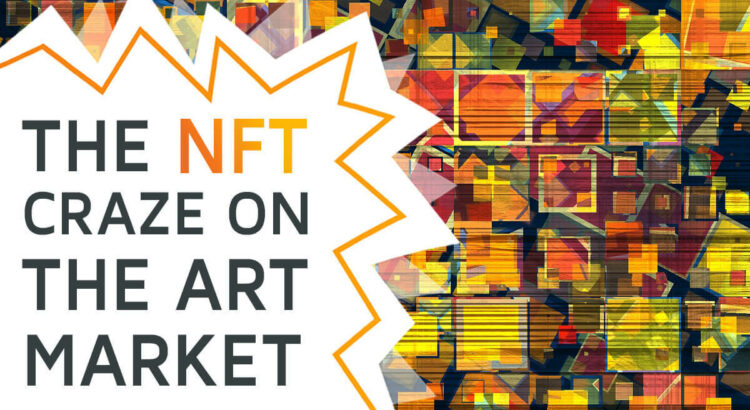Intro

Everyone and his dog have been talking and writing about NFT (non-fungible tokens) in the last couple of months. I don’t know where exactly this hype is currently coming from. NFT is not a new concept, it has been around for a couple of years already.
Back in February 2019, I wrote an article about different use cases of blockchain technology in art, which also mentions a couple of older non-fungible token projects like Crypto Kitties or Rare Pepe Trading Cards, so-called digital collectibles. In October 2019 we even started our very own NFT project Value Manifesto together with the art historian Timo Niemeyer, mechanical engineer Matthias Frank and producer of Nixie Tubes Dalibor Farny.
So, nothing new under the sun. But suddenly everybody is talking about the NFTs and NFT-based art is being sold for tens of Millions of dollars. It looks like the concept of certification of art ownership on the blockchain is suddenly lightning-fast going mainstream. However, what currently happens in the art market, rather reminds me of the famous dot-com bubble at the end of the 1990s. Let’s have a closer look at the events of the past few months.
What Is NFT?
However, before we talk about the most famous NFT-based art projects that were hitting the headlines recently, I’d like to briefly explain what NFT actually is. Non-fungible tokens are tokens issued on a blockchain and used to certify and secure the uniqueness and identity of something (any physical good or intangible item) as well as to track the provenance and the ownership of that thing. NFTs are not exchangeable and not divisible as opposed to fungible tokens, which can be compared with a fiat money unit (e.g. to 1 EUR which is divisible into smaller units/cents and easily exchangeable with another 1 EUR).
The common blockchains such as Ethereum, Bitcoin Cash, Flow each have their own token standards to define their use of NFTs, but probably the most widely used standard for the NFTs so far is the Ethereum-721 standard.
The NFT Hype
Now let’s have a look at the madness happening with NTF-based creations on the art market in the last couple of months. Here are some examples of famous NFT sales:
A batch of 34 digital collectibles known as CryptoPunks was sold for around 1 Mio USD (in ETH) in just minutes to an unknown investor. (Feb 2021)
The NFT for a ‘Nyan Cat’ gif picture was sold for 560.000 USD (in ETH). (Feb 2021)
A Banksy piece bought by a group of crypto-savvy artists, burned in a park and memorialized as an NFT has sold for 380.000 USD (in ETH) (March 2021)
The artist Fynn Kliemann sells a collection of jingles for 250.000 EUR (March 2021)
And to top them all, “Everydays – The First 5000 Days” – an NFT-based artwork by Beeple – was sold on Christie’s auction for 69 Million USD, making the author the third most expensive living artist at auction. The opening bid was just 100 USD by the way. (March 2021)
There are also other examples of NFT-based objects, not necessarily artworks, which are being sold for a lot of money like the very first tweet of Jack Dorsey or the NFTs allowing you to play beer pong with the rapper Post Malone.
“Is This Art or Can It Be Removed?”
Many people believe that the current developments around NFTs in the past few months is just weird and sick and the prices are completely unjustified.
Others argue that the link between the NFT and the associated artwork is the weak point in the concept, because it’s arbitrarily changeable, particularly when you are selling NFTs on a centralized platform like OpenSea.
To draw attention to these issues a couple of artists started anti-NFT campaigns.
As a satire about supposedly overvalued artworks Alex Ramírez-Mallis from NYC and his friends successfully sell NFTs for audio files containing recorded farts, each for 85 USD.
A crypto artist known as “Neitherconfirm” deliberately exchanged the images associated with his OpenSea tokens from computer-generated portraits into photos of carpets, alluding to the act of pulling the rug out from under victims’ feet.
While I can understand concerns about the exchangeability of the items associated with an NFT, which is a real issue that has to be solved, I cannot understand the argument of overvaluation and unjustified prices for art objects. The valuation of art objects is not an issue with NFTs associated with those items. The price is defined and accepted by people. And at the end of the day any art objects cost exactly as much as the people buying them are willing to pay – isn’t this one of the basic principles of a free market?
To explain my position I’d like to remind you that artists were selling “shit” for a lot of money long before the blockchain or NFT era. Sometimes it was even literally “shit”, like a 1961 artwork by the Italian artist Piero Manzoni “Merda d’artista” (“Artist’s Shit”), consisting of 90 tin cans, each filled with 30 grams of faeces. Some cans were sold for thousands of dollars. In August 2016, at an art auction in Milan, one of the tins sold for a new record of 275,000 EUR.
In Germany they say: ”Is this art or can it be removed?” This sentence has its origins in a discussion around the work of the German artist Joseph Beuys, whose artworks were damaged a couple of times unintentionally, because the people didn’t recognize them as art. E.g. in 1973 two women cleaned up a baby bathtub Beuys had wrapped in gauze and bandages so they could use the container to wash dishes after an event. And in 1986, a custodian in the Art Academy of Düsseldorf cleaned up the abstract work “Fat Corner”, five kilograms of butter in a corner of an art room, because he couldn’t bear how it smelled.
Well, we may like or not like artworks which are being sold with NFTs and we may ask ourselves: Is this art or can it be removed? But to stay fair: Are NFTs to be blamed for the valuation and extravagant prices that people are paying for the art objects associated with them?
Conclusion
Like many other inventions, non-fungible tokens can be used for the good or for the bad thing. You can use nuclear power to produce electricity or to create weapons. It depends on what you make out of it. NFT is just a tool and should not be made responsible for the overvaluation of artworks or scam projects around it.
I don’t know if the NFT art hype will die down as quickly as it began or whether it will develop further and we will be witnesses of a big NFT art bubble crash. In any case I hope that the situation around NFTs as a tool will soon return to normal. There are a couple of technical questions that need to be answered and when it happens, NFTs can become a common, secure and reliable means of digital certificates for ownership and provenance tracking of valuable items without a need for the buyers to trust the selling party or to have a trustful broker in between.


